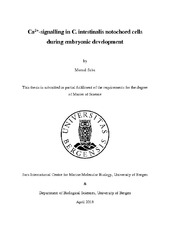Ca^2+-signalling in C. intestinalis notochord cells during embryonic development
Abstract
C. intestinalis notochord is an essential structure during embryonic development, conveying position and fate information, in addition to serving as a structural support and enabling locomotion during larval stage. Researchers have previously presented Ca^2+-signalling as a key element in development of many organisms, but few have performed detailed studies on C. intestinalis. This thesis aimed to elucidate the mechanism underlying Ca^2+-signalling in developing C. intestinalis notochord, through four sub-aims: 1) Determine whether the notochord cells exhibit Ca^2+-signalling activity during development, 2) Determine the contribution of various subcellular compartments, known to store/release Ca^2+, to the observed Ca^2+-signalling activity, 3) Study the mechanisms underlying Ca^2+-signalling in the notochord cells, and 4) Study the effects of calcium pathway on the actomyosin network, which mediates cell motility and cell shape changes. The results present evidence of Ca^2+-signalling in C. intestinalis notochord cells at all studied developmental stages; as continues blips, waves, and short/long lasting blinks in individual cells, and/or blinks travelling in-between cells. Waves seem to dominate stages 22-24, whereas blinks appear to dominate stages 24-26. For the sake of simplicity, the Δ used in this context stands for “change in”. There is a significant difference in terms of number of peaks, (Δ) peak intensity and (Δ) duration, between stage 22 and 23, and from stage 24 and onwards, but not between stage 23 and 24. The number of peaks appears to depend on cation channels and gap junctions, whereas the (Δ) signal intensity seems to rely on cation channels, gap junctions, IP3R and SOCE. As for (Δ) signal duration, it might depend on IP3R and SOCE as well. Furthermore, calmodulin is indicated to be important during stage 23 but not during stage 22, insignificant for number of peaks except for stage 23, and its significance various from stage 24-26. With regards to SERCA, stage 22, and 24-25 suggest independence, whereas stage 23 and 26 seem to depend to some degree. Calmodulin and SERCA data also indicate cell non-autonomous behaviour, as it is hinted in calmodulin RNAi with regards to differences in both AP and M compared to wild type. Ca^2+-signalling inhibition also affects the notochord actomyosin network. Specifically, Gado^3+ and 2APB affect the cell structures and protein expression already from 3hpi and onwards. Carbenoxolone inhibition, on the other hand, leads to visually different protein expression and cell shape from 6hpi and onwards. Lastly, this study further presents Ca^2+-signalling in epidermal and muscle cell, implying importance in tail relaxation, twitching, and movement during embryonic development.
